 W
WIt was announced in the London Gazette on 23 April 1816 that the Prince Regent had been graciously pleased, in the name and on the behalf of His Majesty, to confer The Waterloo Medal upon every officer, non-commissioned officer and soldier of the British Army who took part in one or more of the following battles: Ligny, Quatre Bras and Waterloo.
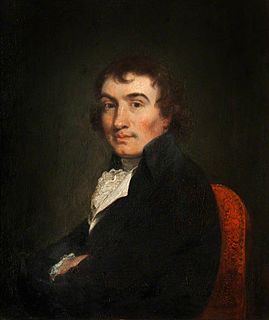 W
WColonel Alexander Abercromby, was a senior British Army officer during the Napoleonic Wars. He also served for a short time as a Member of Parliament for Clackmannanshire.
 W
WGeneral Sir Frederick Adam was a Scottish major-general at the Battle of Waterloo, in command of the 3rd (Light) Brigade. He was the fourth son of William Adam of Blair Adam and his wife Eleanora, the daughter of Charles Elphinstone, 10th Lord Elphinstone. He was later a Lord High Commissioner of the Ionian Islands, who built Mon Repos, Corfu and other important landmarks in that Protectorate.
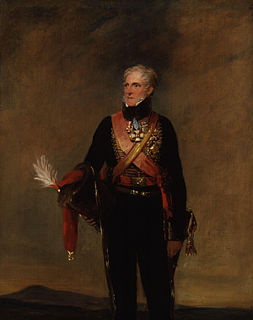 W
WField Marshal Henry William Paget, 1st Marquess of Anglesey,, styled Lord Paget between 1784 and 1812 and known as the Earl of Uxbridge between 1812 and 1815, was a British Army officer and politician. After serving as a Member of Parliament for Carnarvon and then for Milborne Port, he took part in the Flanders Campaign and then commanded the cavalry for Sir John Moore's army in Spain during the Peninsular War; his cavalry showed distinct superiority over their French counterparts at the Battle of Sahagún and at the Battle of Benavente, where he defeated the elite chasseurs of the French Imperial Guard. During the Hundred Days he led the charge of the heavy cavalry against Comte d'Erlon's column at the Battle of Waterloo. At the end of the battle he lost part of one leg to a cannonball. In later life he served twice as Master-General of the Ordnance and twice as Lord Lieutenant of Ireland.
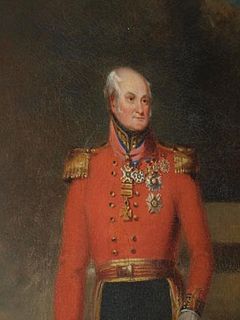 W
WGeneral Sir Robert Arbuthnot, KCB was a British military commander during the Napoleonic Wars. He was a General in the army, a colonel in the 76th Regiment. He was a Brigadier General in the Portuguese Service and was appointed a Knight of the Tower and Sword of Portugal (KTS).
 W
WSir Henry Askew KCB was an officer of the British Army. He served during the Napoleonic Wars and fought at the Battle of Waterloo. He rose to the rank of lieutenant-general during his career.
 W
WLieutenant General Sir Edward Barnes, was a British soldier who became governor of Ceylon.
 W
WMajor-General Sir Charles Broke Vere, né Broke, was a British soldier and Conservative Member of Parliament.
 W
WLieutenant-General Sir Colin Campbell was a British Army officer and colonial governor.
 W
WMajor-General Sir Neil Campbell CB was a British Army officer who fought during the Napoleonic Wars, administered several British colonies, and escorted Napoleon Bonaparte into exile.
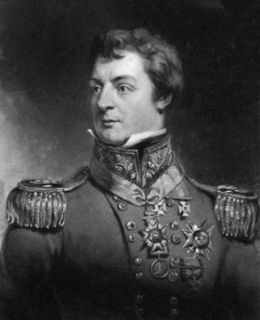 W
WMajor-general Sir James Carmichael-Smyth, 1st Baronet, was a British Army officer and colonial administrator.
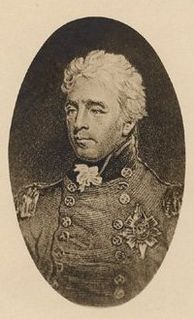 W
WGeneral Charles Murray Cathcart, 2nd Earl Cathcart, styled Lord Greenock between 1814 and 1843, was a British Army general who became Governor General of the Province of Canada. He was a keen amateur geologist, with enough recognition to warrant being made a Fellow of the Royal Society of Edinburgh.
 W
WGeneral Sir James Charles Chatterton, 3rd Baronet, was a British Army officer and politician; he was the third and last of the Chatterton baronets of Castle Mahon. He fought during both the Peninsular and Waterloo Campaigns, later becoming Member of Parliament (MP) for Cork, Ireland.
 W
WGeneral Sir Arthur Benjamin Clifton KSA KSW was a British soldier who fought in the Peninsular War and commanded the Second Union Cavalry Brigade at the Battle of Waterloo on 18 June 1815.
 W
WGeneral Sir Charles Colville was a British Army officer who served during the Napoleonic Wars. He was an ensign in 1781. He served in the West Indies from 1791 to 1797 and while serving there was promoted to lieutenant-colonel (1796). He helped to suppress the Irish Rebellion of 1798. He was in Egypt in 1801 and fought at Martinique in 1809. He commanded brigade, and afterwards division, in the Peninsular War from 1810 until 1814. During the Waterloo Campaign of 1815 he commanded a division in Belgium and the same year was made a K.C.B.. In 1819 he was promoted to lieutenant-general and served as commander-in-chief at Bombay from 1819 until 1825. He was governor of Mauritius from 1828 until 1834. He was promoted to general in 1837.
 W
WSir Robert Henry Dick KOV was a Scottish soldier, son of a doctor in the East India Company's service.
 W
WMajor General Sir Alexander Dickson was a British Army officer who served in the artillery. He fought at many battles during the Napoleonic Wars. Arthur Wellesley, 1st Duke of Wellington had the highest opinion of his abilities and made him the effective commander of his army's artillery during the latter part of the Peninsular War.
 W
WWilhelm Caspar Ferdinand Freiherr von Dörnberg was a German general. He was also known as 'Aufstandsdörnberg' or 'Uprising Dörnberg', for his part in the German campaign of the Napoleonic Wars. He also fought as a brigade commander at Quatre Bras and Waterloo.
 W
WLieutenant-General Sir Neil Douglas was a British Army officer who fought at the 1815 Battle of Waterloo and later became Commander-in-Chief, Scotland.
 W
WLieutenant-General Sir John Elley KMT KSG was a British soldier who joined the cavalry as a private, and rose to general officer rank. He fought with distinction during the French Revolutionary and Napoleonic Wars, and later served as the last Governor of Galway and as Colonel of the 17th Lancers.
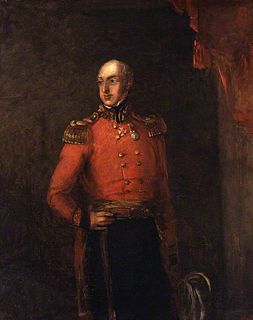 W
WMajor-General William George Keith Elphinstone CB was an officer of the British Army during the 19th century.
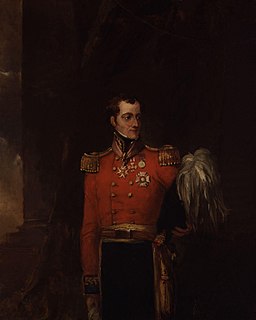 W
WField Marshal Sir William Maynard Gomm was a British Army officer. After taking part in the Anglo-Russian invasion of Holland, he served in most of the battles of the Napoleonic Wars. During the Hundred Days he took part in both the Battle of Quatre Bras and the Battle of Waterloo. He went on to be Commander of the troops in Jamaica and in that role established new barracks at Newcastle, Jamaica, high in the mountains. After that he became Governor of Mauritius and, finally, Commander-in-Chief, India, in which role he introduced promotion examinations for officers.
 W
WGeneral Sir Charles Stephen Gore, also styled as the Honorable Charles Gore, was a British general.
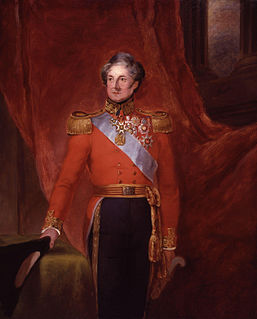 W
WGeneral Sir Colin Halkett (1774–1856) was a British Army officer who became Lieutenant Governor of Jersey.
 W
WCaptain William Hay CB was the second and last junior Joint Commissioner of Police of the Metropolis, one of two heads of the London Metropolitan Police.
 W
WSir Francis Bond Head, 1st Baronet KCH PC, known as "Galloping Head", was Lieutenant-Governor of Upper Canada during the rebellion of 1837.
 W
WGeneral Rowland Hill, 1st Viscount Hill, was a British Army officer who served in the Napoleonic Wars as a trusted brigade, division and corps commander under the command of the Duke of Wellington. He became Commander-in-Chief of the British Army in 1828.
 W
WGeneral Sir James Vaughan Jackson, GCB, KH was an Irish officer in the British Army.
 W
WGeneral Sir James Kempt, was a British Army officer, who served in the Netherlands, Egypt, Italy, the Peninsula, and British North America during the Napoleonic Wars. He led a British brigade at the Battle of Waterloo and later became Governor General of Canada.
 W
WGeneral Sir John Lambert was a British Army officer who served in the French Revolutionary Wars, the Napoleonic Wars and the War of 1812. He is best known for his consummate actions whilst commanding the tenth brigade during the Battle of Waterloo, which kept open the vital line of communication between Hougoumont farmhouse and the rest of the Allied army.
 W
WGeneral Sir James Macdonell or Macdonnell was a Scottish officer of the British Army.
 W
WGeneral Sir Peregrine Maitland, GCB was a British soldier and colonial administrator. He also was a first-class cricketer from 1798 to 1808 and an early advocate for the establishment of what would become the Canadian Indian residential school system.
 W
WJohn Gideon Millingen (1782–1862) was a British army surgeon and author. He was the brother of James Millingen and an uncle of Julius Michael Millingen.
 W
WMajor-General Sir Denis Pack (c.1772–1823) was an Anglo-Irish military officer during the Napoleonic Wars.
 W
WMajor General Hon. Sir Frederick Cavendish Ponsonby was an Anglo-Irish military officer.
 W
WField Marshal FitzRoy James Henry Somerset, 1st Baron Raglan,, known before 1852 as Lord FitzRoy Somerset, was a British Army officer. When a junior officer, he served in the Peninsular War and the Hundred Days, latterly as military secretary to the Duke of Wellington. He also took part in politics as Tory Member of Parliament for Truro, before becoming Master-General of the Ordnance. He became commander of the British troops sent to the Crimea in 1854: his primary objective was to defend Constantinople, and he was also ordered to besiege the Russian Port of Sevastopol. After an early success at the Battle of Alma, a failure to deliver orders with sufficient clarity caused the fateful Charge of the Light Brigade at the Battle of Balaclava. Despite further success at the Battle of Inkerman, a poorly coordinated allied assault on Sevastopol in June 1855 was a complete failure. Raglan died later that month, after suffering from dysentery and depression.
 W
WField Marshal Sir Hew Dalrymple Ross, was a British Army officer. After seeing active service during the Irish Rebellion of 1798, he fought as a troop commander in many of the battles of the Peninsular War and the Hundred Days. He went on to become the Artillery Commander, Northern District with delegated command over all the forces of the four northern counties before being promoted to Deputy Adjutant-General, Royal Artillery. Ross was the last person to hold the title of Lieutenant-General of the Ordnance, assuming responsibility for the artillery component sent to take part in the Crimean War under Lord Raglan. After the war he served as Master Gunner, St James's Park, a senior ceremonial post in the Royal Artillery.
 W
WLieutenant-Colonel Sir Charles Rowan was an officer in the British Army, serving in the Peninsular War and Waterloo and the joint first Commissioner of Police of the Metropolis, head of the London Metropolitan Police.
 W
WField Marshal Sir William Shearman Rowan, was a British Army officer. He served in the Peninsular War and then the Hundred Days, fighting at the Battle of Waterloo and taking part in an important charge led by Sir John Colborne against the Imperial Guard when he was wounded. He later assisted Colborne in Colborne's new role as Acting Governor General of British North America during the rebellions by the Patriote movement in 1837. Rowan returned to Canada as Commander-in-Chief, North America in which role he made an important conciliatory speech in response to the burning of the Parliament Buildings in Montreal by an angry mob in April 1849.
 W
WLieutenant-General Alexander George Fraser, 17th Lord Saltoun KStG KMT, was a Scottish representative peer and a British Army general who fought in the Napoleonic Wars and the First Opium War.
 W
WGeneral Sir George Scovell, was a member of the quartermaster's staff of the British Army in Iberia during the Peninsular War.
 W
WField Marshal John Colborne, 1st Baron Seaton, was a British Army officer and colonial governor. After taking part as a junior officer in the Anglo-Russian invasion of Holland, Sir Ralph Abercromby's expedition to Egypt and then the War of the Third Coalition, he served as military secretary to Sir John Moore at the Battle of Corunna. He then commanded the 2nd Battalion of the 66th Regiment of Foot and, later, the 52nd Regiment of Foot at many of the battles of the Peninsular War. At the Battle of Waterloo, Colborne on his own initiative brought the 52nd Regiment of Foot forward, took up a flanking position in relation to the French Imperial Guard and then, after firing repeated volleys into their flank, charged at the Guard so driving them back in disorder.
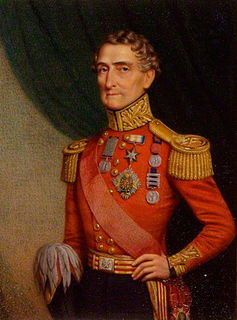 W
WLieutenant-General Sir Henry George Wakelyn Smith, 1st Baronet, was a notable English soldier and military commander in the British Army of the early 19th century. A veteran of the Napoleonic Wars, he is also particularly remembered for his role in the Battle of Aliwal (India) in 1846, and as the husband of Lady Smith.
 W
WGeneral Lord Robert Edward Henry Somerset was a British soldier who fought during the Peninsular War and the War of the Seventh Coalition.
 W
WField Marshal John Byng, 1st Earl of Strafford, of 6 Portman Square, London, of Ballaghy, Londonderry and latterly of Wrotham Park in Middlesex, and of 5, St James's Square, London, was a British Army officer and politician. After serving as a junior officer during the French Revolutionary Wars and Irish Rebellion of 1798, he became Commanding Officer of the Grenadier Battalion of the 3rd Regiment of Foot Guards during the disastrous Walcheren Campaign. He served as a brigade commander at the Battle of Vitoria and then at the Battle of Roncesvalles on 25 July 1813 when his brigade took the brunt of the French assault and held its position for three hours in the early morning before finally being forced back. During the Hundred Days he commanded the 2nd Guards Brigade at the Battle of Quatre Bras in June 1815 and again at the Battle of Waterloo later that month when light companies from his brigade played an important role in the defence of Château d'Hougoumont. He went on to be Commander-in-Chief, Ireland and, after leaving Ireland in 1831, he was elected as Whig Member of Parliament for Poole in Dorset and was one of the few military men who supported the Reform Bill, for which he was rewarded with a peerage.
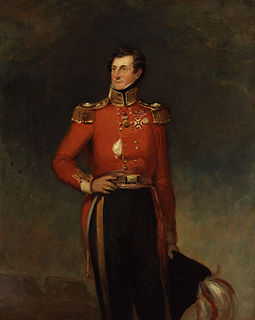 W
WColonel Sempronius Stretton (1781–1842) was a British Army officer who served in numerous campaigns including the Battle of Waterloo. He is also known for his sketches that recorded early Canadian life.
 W
WLieutenant General Richard Hussey Vivian, 1st Baron Vivian, known as Sir Hussey Vivian from 1815 to 1828 and Sir Hussey Vivian, Bt, from 1828 to 1841, was a British cavalry leader from the Vivian family.
 W
WLieutenant-General Sir John William Waters KCB was a Welsh officer in the British Army during the Napoleonic Wars.
 W
WArthur Wellesley, 1st Duke of Wellington, was an Anglo-Irish soldier and Tory statesman who was one of the leading military and political figures of 19th-century Britain, serving twice as prime minister. He ended the Napoleonic Wars when he defeated Napoleon at the Battle of Waterloo in 1815.
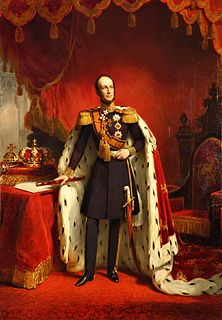 W
WWilliam II was King of the Netherlands, Grand Duke of Luxembourg, and Duke of Limburg.
 W
WField Marshal Sir Alexander George Woodford, GCB, KCMG, was a British Army officer. After taking part in the Anglo-Russian invasion of Holland, he served in most of the battles of the Napoleonic Wars. During the Hundred Days he commanded the 2nd battalion of the Coldstream Guards at the Battle of Quatre Bras, the Battle of Waterloo and the storming of Cambrai. He went on to become lieutenant governor and brigade commander at Malta, lieutenant governor and brigade commander at Corfu and then commander of the British garrison on the Ionian Islands before being appointed Governor and Commander-in-Chief of Gibraltar.